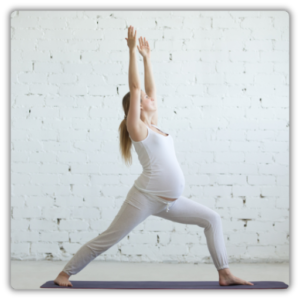 Pregnancy is a transformative journey, and staying active through prenatal yoga can help support a healthy pregnancy by easing discomfort, improving flexibility, and strengthening the body. Prenatal yoga poses are designed to be safe and effective at every stage, helping pregnant women build strength, reduce stress, and prepare for childbirth. Whether you’re new to yoga or an experienced yogi, incorporating yoga into your routine can provide benefits during pregnancy while keeping you connected to your body and mind.
Pregnancy is a transformative journey, and staying active through prenatal yoga can help support a healthy pregnancy by easing discomfort, improving flexibility, and strengthening the body. Prenatal yoga poses are designed to be safe and effective at every stage, helping pregnant women build strength, reduce stress, and prepare for childbirth. Whether you’re new to yoga or an experienced yogi, incorporating yoga into your routine can provide benefits during pregnancy while keeping you connected to your body and mind.
Here are the best yoga poses for a healthy pregnancy, broken down by trimester.
KEY POINTS
Prenatal yoga supports a healthy pregnancy by improving flexibility, reducing stress, and strengthening the body.
Gentle poses in the first trimester help with circulation and managing early pregnancy discomforts.
Strength-building poses in the second trimester stabilize the pelvis, support posture, and improve balance.
The third trimester focuses on hip openers, breathing techniques, and relaxation to prepare for labor.

Pop in your email below, and we’ll zip it straight to your inbox so you never lose it!
First Trimester: Gentle Beginnings
The first trimester is all about adapting to changes. With hormone fluctuations and early pregnancy symptoms, many women experience fatigue, nausea, and even aches and pains in the lower back. This is a great time to establish a well-rounded yoga practice that focuses on gentle movements, deep breath awareness, and improving circulation.
Poses to Try:
- Konasana (Angle Pose) – This gentle yoga pose improves spinal flexibility and enhances circulation. Stand with your feet hip-width apart, extend your left arm overhead, and lean sideways to open the spine and stretch the inner thighs.
- Cat-Cow Pose – Helps ease back pain and promotes mobility in the spine. Start on your hands and knees, round your back as you inhale, and arch as you exhale to keep the pelvis flexible.
- Seated Forward Fold – A restorative stretch for the low back, helping to relieve tension and improve blood flow.
During this stage, avoid lying flat on your back for long periods and be mindful of hormone relaxin, which can make joints more flexible and prone to overstretching.
Second Trimester: Strengthening the Body
As you move into the second trimester, your energy levels may return, and your growing belly shifts your posture. Strength-building prenatal yoga can help stabilize the pelvis, support the lower back, and improve balance.
Poses to Try:
- Warrior II – This standing yoga pose strengthens the thighs, opens the torso, and improves stability. Place your hands on your hips for extra support.
- Lunges – Helps stabilize the pelvic floor and relieve back discomfort. Step your right foot forward, bend your right knee, and keep your left foot behind you for balance.
- Downward Dog – Stretches the spine, ankle, and lower back, promoting circulation and flexibility. Modify by placing a yoga block under your hands if needed.
Since pregnancy yoga poses can challenge balance, use support when necessary and be cautious with certain poses that involve deep backbends or twists.
Third Trimester: Preparing for Labor

In the third trimester, as the body prepares for birth, gentle and restorative poses help pregnant women stay comfortable and relieve tension. The focus is on hip openers, breathing exercises, and relaxation techniques to prepare you for labor.
Poses to Try:
- Malasana (Yogi Squat) – Opens the pelvis, strengthens the thighs, and prepares the body for birth. Bend your knees, keep your spine tall, and use a yoga block under your hips if needed.
- Butterfly Pose – A restorative stretch that improves flexibility in the lower back and hips. Sit with the soles of your feet together, gently pressing the knees down.
- Side-Lying Savasana – Since it’s best to avoid lying flat, this prenatal yoga variation promotes deep relaxation while reducing lower back tension.
As the trimester of pregnancy progresses, avoid intense balancing poses and focus on poses that will help create space for the baby.
The Power of Breath: Connecting Mind and Body
Throughout your yoga practice, breathwork is essential for managing stress, improving oxygen flow, and preparing the body for labor. Deep breath awareness helps regulate emotions, reduce tension in the lower back, and create a deeper connection between body and mind.
Looking to take control of your weight & nutrition?

Breathing Techniques to Try:
- Diaphragmatic Breathing – Place one hand on your abdomen and the other on your chest. Inhale deeply through your nose, expanding your torso, and exhale slowly, feeling your belly contract. This technique strengthens the pelvic floor and relieves lower back pain.
- Alternate Nostril Breathing – A calming breath practice that balances energy and reduces stress, especially in the third trimester when sleep disruptions and aches and pains are common.
- Ocean Breath (Ujjayi Breathing) – A steady, controlled breath that improves endurance during pregnancy yoga poses and can be especially helpful during contractions.
By incorporating mindful breathing into your prenatal yoga sessions, you can enhance relaxation, increase lung capacity, and feel more centered throughout your pregnancy.
Prenatal yoga is a fantastic way to stay active, ease common pregnancy discomforts, and strengthen the body for birth. A certified prenatal yoga teacher can guide you through modifications for poses and ensure a safe, comfortable pregnancy. Always listen to your body and enjoy a happy yoga practice as you move through each trimester.
If you’re looking for a gentle and effective way to stay active during pregnancy, check out this 22-minute prenatal yoga practice: Prenatal Yoga | 22-Minute Home Yoga Practice.











